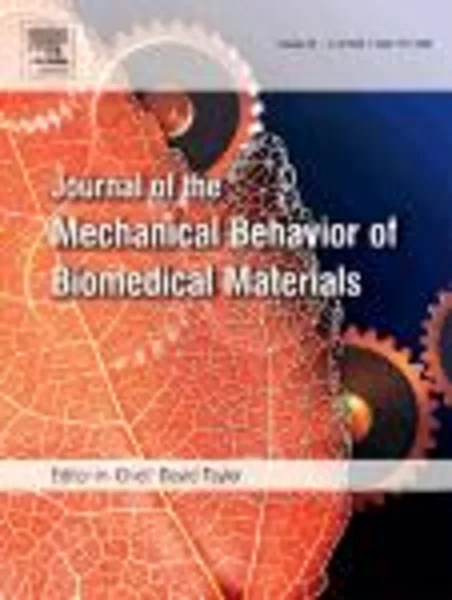-
numerical model of bone remodeling sensitive to loading frequency through a poroelastic behavior and internal fluid movements
جزئیات بیشتر مقاله- تاریخ ارائه: 1394/01/01
- تاریخ انتشار در تی پی بین: 1394/01/01
- تعداد بازدید: 852
- تعداد پرسش و پاسخ ها: 0
- شماره تماس دبیرخانه رویداد: -
in this article, a phenomenological numerical model of bone remodeling is proposed. this model is based on the poroelasticity theory in order to take into account the effects of fluid movements in bone adaptation. moreover, the proposed remodeling law is based on the classical ‘stanford’ law, enriched in order to take into account the loading frequency, through fluid movements. this coupling is materialized by a quadratic function of darcy velocity. the numerical model is carried out, using a finite element method, and calibrated using experimental results at macroscopic level, from the literature. first results concern cyclic loadings on a mouse ulna, at different frequencies between 1hz and 30hz, for a force amplitude of 1.5 n and 2 n. experimental results exhibit a sensitivity to the loading frequency, with privileged frequency for bone remodeling between 5hz and 10 hz, for the force amplitude of2 n. for the force amplitude of 1.5 n, no privileged frequencies for bone remodeling are highlighted. this tendency is reproduced by the proposed numerical computations. the model is identified on a single case (one frequency and one force amplitude) and validated on the other ones. the second experimental validation deals with a different loading regime, an internal fluid pressure at 20 hz on a turkey ulna. the same framework is applied, and the numerical and experimental data are still matching in terms of gain in bone mass density.
مقالات جدیدترین رویدادها
-
استفاده از تحلیل اهمیت-عملکرد در ارائه الگوی مدیریت خلاقیت سازمانی و ارائه راهکار جهت بهبود
-
بررسی تاثیر ارزش وجوه نقد مازاد بر ساختار سرمایه شرکت های پذیرفته شده در بورس اوراق بهادار تهران
-
بررسی تأثیر سطح افشای ریسک بر قرارداد بدهی شرکت های پذیرفته شده در بورس اوراق بهادار تهران
-
بررسی تأثیر رتبه بندی اعتباری مبتنی بر مدل امتیاز بازار نوظهور بر نقد شوندگی سهام با تأکید بر خصوصی سازی شرکت ها
-
تأثیر آمیخته بازاریابی پوشاک ایرانی بر تصویر ذهنی مشتری پوشاک ایرانی (هاکوپیان)
-
بررسی تغییر اندازه سنگ دانه ها بر روی خواص رئولوژیکی و مکانیکی بتن خود تراکم سبک ساخته شده با پوکه معدنی
-
شهرسازی و توسعه ناپایدار شهری؛ مطالعه موردی متروپل تبریز
-
بررسی مدلهای موجود برای هدایت حرارتی و ویسکوزیته در نانوسیال ها
-
بررسی آسیب شناسی آموزش مجازی درس علوم در دوره پیش دبستانی از منظر مربیان شهر میاندوآب
-
biosynthesis of benzoylformic acid from benzoyl cyanide by a newly isolated rhodococcus sp. cczu10-1 in toluene–water biphasic system
مقالات جدیدترین ژورنال ها
-
مدیریت و بررسی افسردگی دانش آموزان دختر مقطع متوسطه دوم در دروان کرونا در شهرستان دزفول
-
مدیریت و بررسی خرد سیاسی در اندیشه ی فردوسی در ادب ایران
-
واکاوی و مدیریت توصیفی قلمدان(جاکلیدی)ضریح در موزه آستان قدس رضوی
-
بررسی تاثیر خلاقیت، دانش و انگیزه کارکنان بر پیشنهادات نوآورانه کارکنان ( مورد مطالعه: هتل های 3 و 4 ستاره استان کرمان)
-
بررسی تاثیر کیفیت سیستم های اطلاعاتی بر تصمیم گیری موفق در شرکتهای تولیدی استان اصفهان (مورد مطالعه: مدیران شرکتهای تولیدی استان اصفهان)
-
نقش مدیریت شهری در مناطق حاشیه نشین با تاکید بر ایران
-
مدیریت و کاهش بهای تمام شده، با محوریت طبقه بندی طبیعی هزینه ها در کسب کارهای کارآفرینانه با رویکرد ارزش آفرینی
-
فرآیند پیش نگری ، تاثیرات آن در عکاسی فتوشیمیایی و نحوه احیاء آن در عکاسی دیجیتال
-
scrutinization of the relationship between organizational agility and the application of information and communication technology in the education organization of shirvan township in the year 2015
-
investigating the seismic performance of steel moment-resisting frames by using damage index




سوال خود را در مورد این مقاله مطرح نمایید :